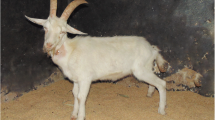Summary
A female dog, inoculated with a rabies isolate from the saliva of an apparently healthy Ethiopian dog, developed rabies but later recovered without supportive treatment. Rabies virus was isolated from the saliva collected 42, 169 and 305 days after recovery. Sixteen months after it recovered, the dog suddenly died after giving birth to two stillborn puppies. At necropsy, viral antigen could be detected in the tonsils and the brain tissue, but viable virus was isolated from the Palatine tonsils only.
Similar content being viewed by others
References
Baer, G. M., Shantha, T. R., Bourne, G. H.: The pathogenesis of street rabies virus in rats. Bull. W.H.O.38, 119–125 (1968).
Bell, J. F.: Latency and abortive rabies. In:Baer, G. M. (ed.), The Natural History of Rabies, Vol. I, 331–354. New York: Academic Press 1975.
Charlton, K. M., Casey, G. A.: Experimental rabies in skunks. Immunofluorescence light and electron microscopic studies. Lab. Invest.41, 36–44 (1979).
Dean, D. J., Evans, W. M., McClure, R. C.: Pathogenesis of rabies. Bull. W.H.O.29, 803–811 (1963).
Diaz, A. M. O., Fuenzalida, E., Bell, J. F.: Nonfatal rabies in dogs and cats. Ann. Microbiol. (Paris)126, 503–509 (1975).
Erlandson, R. A.: A new Maraglas D.E.R. (R) 732 embedment for electron microscopy. J. Cell Biol.22, 704–709 (1964).
Fekadu, M.: Atypical rabies in dogs in Ethiopia (Background document No. 44, Geneva, 11–17 June 1969), as quoted by Bell JF. In:Baer, G. M. (ed.), The Natural History of Rabies, Vol. I, 348. New York: Academic Press 1975.
Fekadu, M.: Atypical rabies in dogs in Ethiopia. Ethiopian Med. J.10, 79–86 (1972).
Fekadu, M.: Asymptomatic non-fatal canine rabies. LancetI, 569 (1975).
Fekadu, M., Baer, G. M.: Recovery from clinical rabies of 2 dogs inoculated with a rabies virus strain from Ethiopia. Am. J. Vet. Res.41, 1632–1634 (1980).
Fekadu, M., Chandler, F. W., Harrison, A. K.: Pathogenesis of rabies in dogs inoculated with an Ethiopian rabies virus strain. Immunofluorescence, histologic and ultrastructural studies of the central nervous system. Arch. Virol.71, 109–126 (1982).
Fekadu, M., Shaddock, J. H., Baer, G. M.: Intermittent excretion of rabies virus in the saliva of a dog two and six months after it had recovered from experimental rabies. Am. J. Trop. Med. Hyg.30, 1113–1115 (1981).
Fischman, H. R., Strandberg, J. D.: Inapparent rabies virus infection of the central nervous system. J. Am. Vet. Med. Assoc.163, 1050–1055 (1973).
Goldwasser, R. A., Kissling, R. E.: Fluorescent antibody staining of street and fixed rabies virus antigen. Proc. Soc. Exp. Biol. Med.98, 219–223 (1958).
Granoff, A.: The interaction of Newcastle disease virus and neutralizing antibody. Virology25, 38–47 (1965).
Hattwick, M. A. W., Weis, T. T., Stechschulte, C. J., Baer, G. M., Gregg, M. B.: Recovery from rabies. A case report. Ann. Intern. Med.76, 931–942 (1972).
Kahn, D. E., Gillespie, J. H.: Feline virus: Pathogenesis of picornavirus infection in cat. Am. J. Vet. Res.32, 521–531 (1971).
Koprowski, H.: The mouse inoculation test. In:Kaplan, M. M., Koprowski, H. (eds.), Laboratory Techniques in Rabies, 3rd ed., 85–93. Geneva: World Health Organization 1973.
Lodmell, D. L., Bell, J. F., Moore, G. J., Raymond, G. H.: Comparative study of abortive and nonabortive rabies in mice. J. Infect. Dis.119, 569–580 (1969).
Lynn, J. A., Martin, J. H., Race, G. J.: Recent improvements of histologic techniques for the combined light and electron microscopic examination of surgical specimens. Am. J. Clin. Pathol.45, 704–713 (1966).
Murphy, F. A., Bauer, S. P.: Early street rabies virus infection in striated muscle and later progression to the central nervous system. Intervirology3, 256–268 (1974).
Murphy, F. A., Bauer, S. P., Harrison, A. K., Winn, W. C.: Comparative pathogenesis of rabies and rabies-like viruses. Viral infection and transit from inoculation site to the central nervous system. Lab. Invest.28, 361–376 (1973).
Murphy, F. A., Bell, J. F., Bauer, S. P., Gardner, J. J., Moore, G. J., Harrison, A. K., Coe, J. E.: Experimental chronic rabies in the cat. Lab. Invest.43, 231–241 (1980).
Murphy, F. A., Harrison, A. K., Winn, W. C., Bauer, S. P.: Comparative pathogenesis of rabies and rabies-like viruses. Infection of the central nervous system and centrifugal spread of virus to peripheral tissues. Lab. Invest.29, 1–16 (1973).
Perl, D. P., Bell, J. F., Moore, G. J., Stewart, S. J.: Chronic recrudescent rabies in a cat. Proc. Soc. Exp. Biol. Med.155, 540–548 (1977).
Porras, C., Jose Barbosa, J., Fuenzalida, E., Adaros, H. L., Oviedo de Diaz, A. M., Furst, J.: Recovery from rabies in man. Ann. Intern. Med.85, 44–48 (1976).
Povey, R. C., Wardly, R. C., Jessen, H.: Feline picornavirus infection: Thein vivo carrier state. Vet. Rec.92, 224–229 (1973).
Veeraraghavan, N.: Studies on the salivary excretion of rabies virus by the dog from Surandi. In: Pasteur Institute Annual Report of the Director, 1968, and Scientific Report, 1969. Madras: Pasteur Institute 1970.
Venable, J. H., Coggeshall, R.: A simplified lead acetate stain for use in electron microscopy. J. Cell Biol.25, 407–413 (1965).
Veterinary Record: Tonsils in the pathogenesis of disease. Vet. Rec.95, 234 (1974).
Vetri, R. W., Sprinkle, P. M., McClung, J. E.: Epstein-Barr virus associated with episodes of recurrent tonsillitis. Arch. Otolaryngol.101, 552–556 (1975).
Wardley, R. C., Povey, R. C.: The pathology and site of persistence associated with three strains of feline calicivirus. Res. Vet. Sci.23, 15–19 (1977).
Wiktor, T. J., Clark, H. F.: Application of the plaque assay technique to the study of rabies-neutralizing antibody interaction. Ann. Microbiol. (Inst. Pasteur)124, 271–282 (1973).
Author information
Authors and Affiliations
Additional information
With 4 Figures
Rights and permissions
About this article
Cite this article
Fekadu, M., Shaddock, J.H., Chandler, F.W. et al. Rabies virus in the tonsils of a carrier dog. Archives of Virology 78, 37–47 (1983). https://doi.org/10.1007/BF01310857
Received:
Accepted:
Issue Date:
DOI: https://doi.org/10.1007/BF01310857




